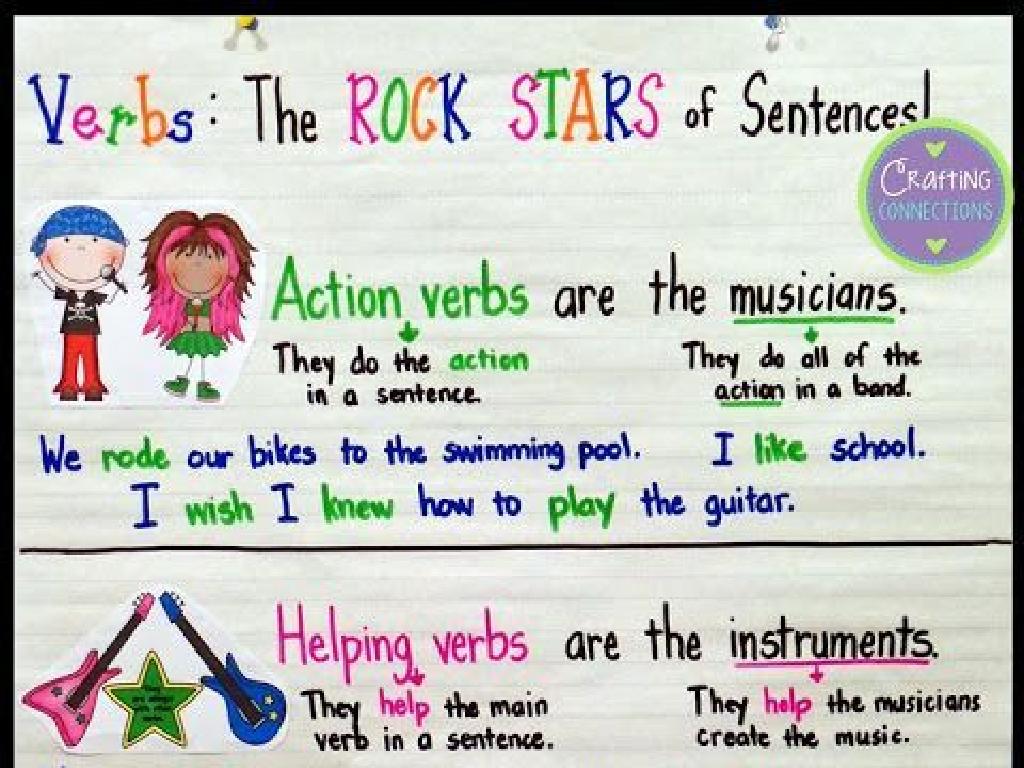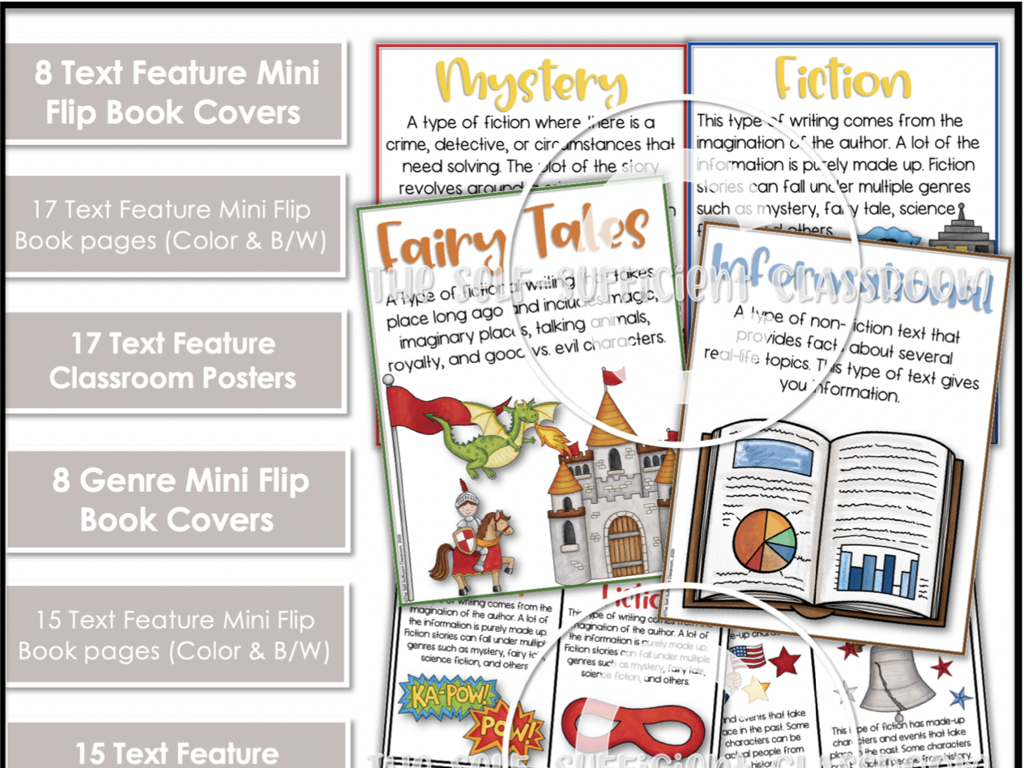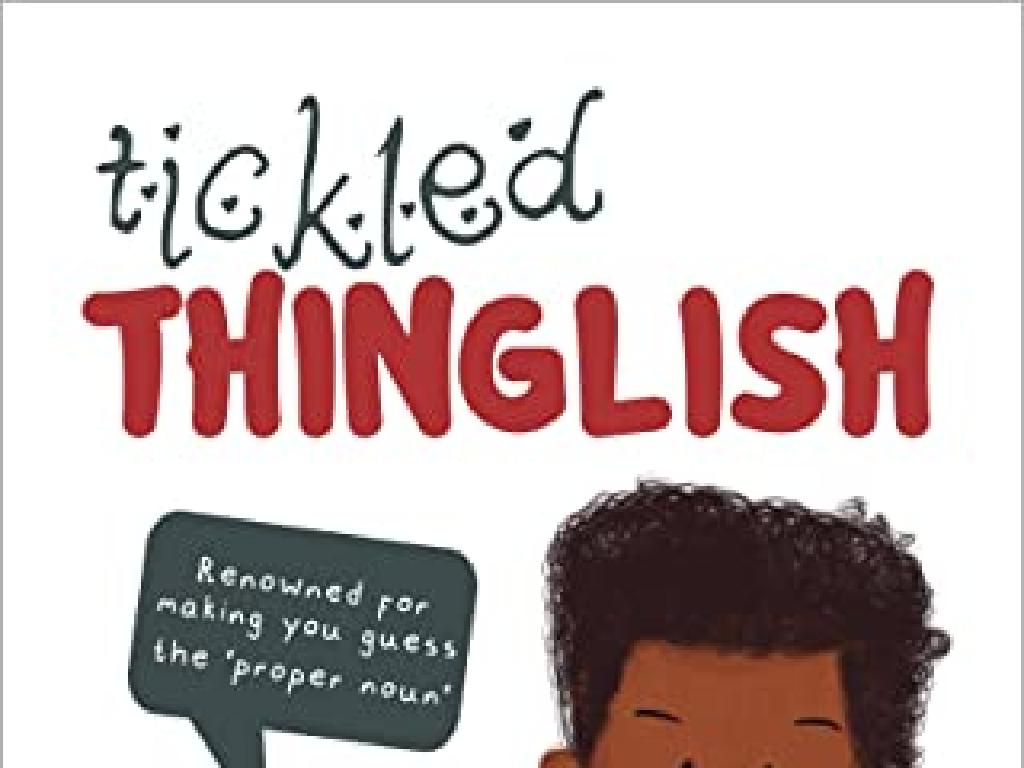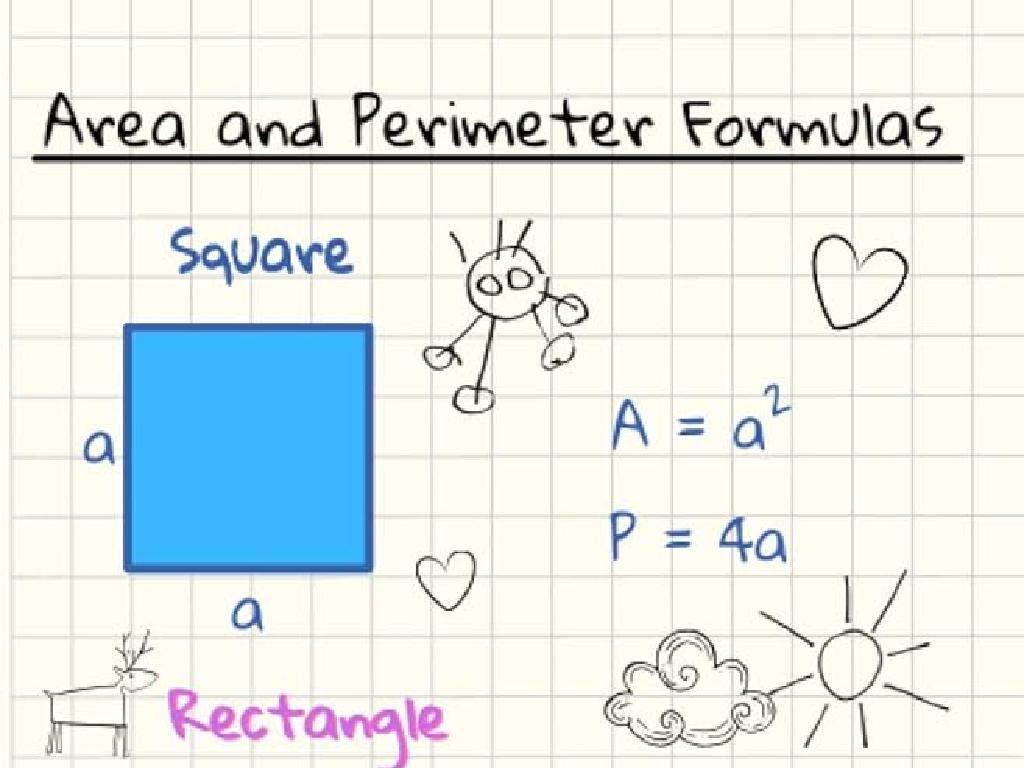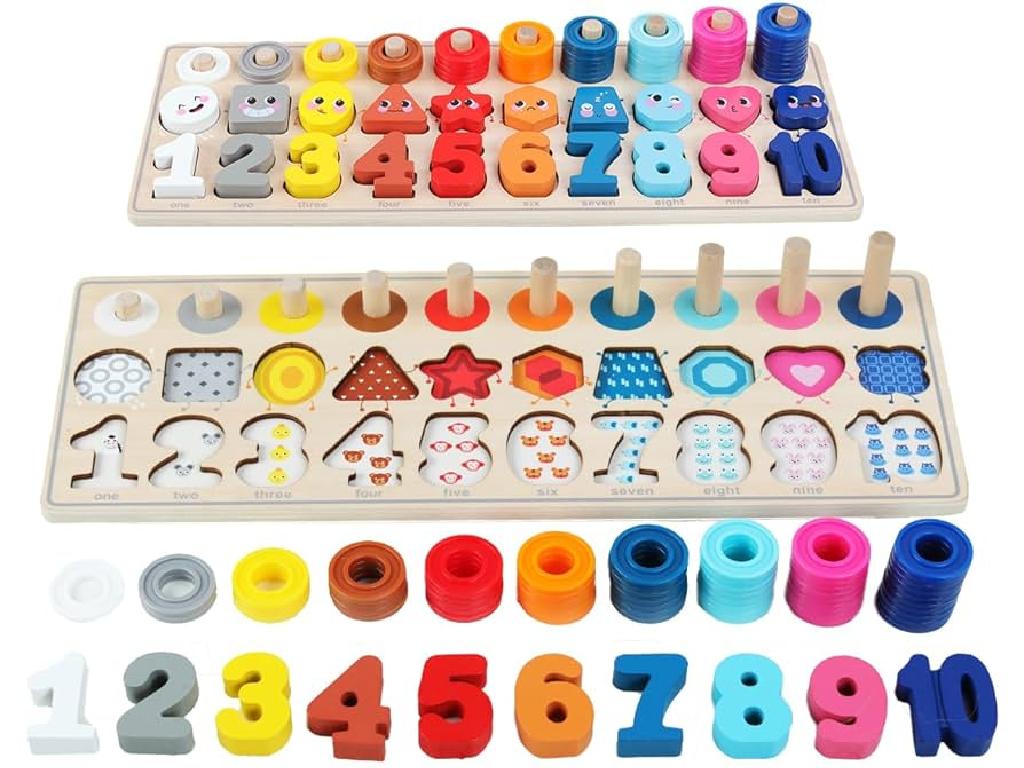Use The Correct Article: A Or An
Subject: Language arts
Grade: Third grade
Topic: Articles
Please LOG IN to download the presentation. Access is available to registered users only.
View More Content
Welcome to Articles!
– Learn about ‘a’ and ‘an’
– ‘a’ is used before words that start with a consonant sound
– When to use ‘a’ or ‘an’
– ‘an’ is used before words that start with a vowel sound
– Practice using articles correctly
– We’ll do fun activities to practice ‘a’ and ‘an’
– Become an article expert
|
This slide introduces the concept of articles ‘a’ and ‘an’ to third graders. Begin by explaining that ‘a’ is used before words that start with a consonant sound, while ‘an’ is used before words that start with a vowel sound (a, e, i, o, u). Provide examples for clarity, such as ‘a cat’ and ‘an apple’. Engage the class with interactive activities where they can practice choosing the correct article based on the initial sound of the following word. Encourage them to listen to the sound rather than just look at the letter, as some words like ‘hour’ start with a consonant letter but have a vowel sound. The goal is for students to understand and apply the rules of using ‘a’ and ‘an’ to become more confident in their writing and speaking abilities.
Understanding Articles: ‘A’ and ‘An’
– Articles define nouns’ specificity
– They tell us if a noun is specific or not, like ‘a dog’ or ‘the dog’.
– ‘A’ and ‘an’ are indefinite articles
– Use ‘a’ before words that start with a consonant sound, ‘an’ before vowel sounds.
– Rules for using ‘a’ and ‘an’
– ‘A’ before words starting with consonant sounds, ‘an’ before vowel sounds (a, e, i, o, u).
– Practice choosing the right article
– We’ll do fun activities to learn choosing ‘a’ or ‘an’ before a noun.
|
This slide introduces the concept of articles in English and focuses on the indefinite articles ‘a’ and ‘an.’ Articles help to determine whether a noun is specific or general. ‘A’ is used before words that begin with a consonant sound, while ‘an’ is used before words that begin with a vowel sound. It’s important to note that the use of ‘a’ or ‘an’ is determined by the sound that follows, not necessarily the first letter of the next word. For example, ‘an hour’ is correct because ‘hour’ starts with a vowel sound. The slide sets the stage for interactive activities where students will practice choosing the correct article based on the noun that follows.
Using the Article ‘A’
– ‘A’ before consonant sounds
– Examples: ‘a cat’, ‘a dog’
– Use ‘a’ before words like cat and dog
– ‘A yellow balloon’ as example
– Notice ‘a’ is used even though ‘yellow’ starts with ‘y’
– Practice saying examples aloud
– Helps with pronunciation and understanding
|
This slide introduces the use of the article ‘a’ which is used before words that begin with a consonant sound. It’s important to emphasize the sound rather than the letter because some words may start with a vowel letter but have a consonant sound, and vice versa. Provide students with clear examples such as ‘a cat’, ‘a dog’, and ‘a yellow balloon’ to illustrate the concept. Encourage the students to practice saying these examples out loud to reinforce the correct usage of ‘a’. This will help them understand and remember the rule. During the next class, you can check their understanding by asking them to provide their own examples.
Using ‘An’ in Sentences
– ‘An’ before vowel sounds
– Use ‘an’ if the next word sounds like it starts with a vowel
– Examples: ‘an apple’, ‘an elephant’
– ‘An’ comes before words that start with A, E, I, O, U sounds
– ‘An igloo’ is also correct
– Practice saying them aloud
– Repeat the examples as a class activity
|
This slide is focused on teaching students the correct usage of the article ‘an’. Emphasize that ‘an’ is used before words that start with a vowel sound, not just a vowel letter. This is an important distinction because some words starting with a vowel letter might not have a vowel sound (e.g., ‘a university’). Provide clear examples and practice them as a class to reinforce learning. Encourage students to listen to the sound that follows ‘an’ and not just look at the first letter of the word. This will help them understand and remember the rule better. During the next class, you can assess their understanding by having them identify and correct sentences that use ‘a’ and ‘an’ incorrectly.
Special Cases: Articles ‘a’ and ‘an’
– ‘a’ before vowel sounds like ‘you’
– Example: ‘a unicorn’ not ‘an unicorn’ because it sounds like ‘you-nicorn’
– ‘an’ before silent ‘h’
– Example: ‘an hour’ not ‘a hour’ because the ‘h’ is silent
– Practice with special cases
– Understanding the rules
– Learn when to use ‘a’ and ‘an’ correctly
|
This slide focuses on the special cases in the use of articles ‘a’ and ‘an’. Emphasize that the choice between ‘a’ and ‘an’ is determined by the sound that follows, not just the letter. For example, ‘a’ is used before words that start with a vowel sound that sounds like ‘you’, such as ‘a unicorn’, not ‘an unicorn’. Conversely, ‘an’ is used before words with a silent ‘h’, such as ‘an hour’, not ‘a hour’. Encourage students to practice by providing more examples and creating sentences together. The goal is for students to understand and apply the rules of article usage in these special cases.
Let’s Practice: A or An?
– Fill in the blank: I saw ___ elephant
– Use ‘an’ before vowel sounds: ‘an elephant’
– Choose ‘a’ or ‘an’: She wants ___ apple
– ‘An’ before ‘apple’ because it starts with a vowel
– Understand when to use ‘a’ or ‘an’
– Share your answers with the class
– Be ready to explain why you chose ‘a’ or ‘an’
|
This slide is for a class activity where students will practice using the articles ‘a’ and ‘an’ correctly. The activity is designed to help them understand that ‘a’ is used before words that begin with a consonant sound, and ‘an’ is used before words that begin with a vowel sound. Encourage students to say the sentences aloud to hear the sound that follows the article. After completing the exercise, ask students to share their answers and explain their choices. This will reinforce their understanding and give them confidence in using articles. For further practice, provide additional examples and encourage students to create their own sentences using ‘a’ and ‘an’ correctly.
Class Activity: Article Hunt
– Engage in a scavenger hunt
– Find objects for ‘a’ or ‘an’
– Does it start with a vowel sound? Use ‘an’. Otherwise, ‘a’.
– Pair up and write answers
– Discuss findings with class
|
This interactive activity is designed to help students understand the use of articles ‘a’ and ‘an’ in a fun and engaging way. Set up a scavenger hunt in the classroom with various objects. Students will work in pairs to find these objects and decide whether to use ‘a’ or ‘an’ based on the initial sound of the word. They should write down their answers to discuss later. As a teacher, facilitate the activity by ensuring students understand that ‘an’ is used before words that start with a vowel sound, not just a vowel letter, and ‘a’ is used before words that start with a consonant sound. After the activity, regroup and discuss the findings, reinforcing the rules and praising correct usage and good teamwork.
Becoming Grammar Pros: Articles ‘A’ and ‘An’
– Congratulations on learning ‘a’ and ‘an’!
– Remember: It’s all about the sound
– Use ‘a’ before words that start with a consonant sound
– Practice makes perfect
– Keep practicing using ‘a’ and ‘an’ in sentences
– You’re becoming grammar pros!
|
This slide is a conclusion to the lesson on articles ‘a’ and ‘an.’ Reinforce the concept that the choice between ‘a’ and ‘an’ depends on the sound that follows the article, not just the first letter of the word. For example, ‘an hour’ because the ‘h’ is silent and the word starts with a vowel sound. Encourage the students to listen carefully to the sounds words make, not just look at the letters. Remind them that practice is key to mastering grammar. Celebrate their progress and encourage them to keep practicing to become true grammar pros. Provide some additional examples if time allows and praise their efforts throughout the lesson.

